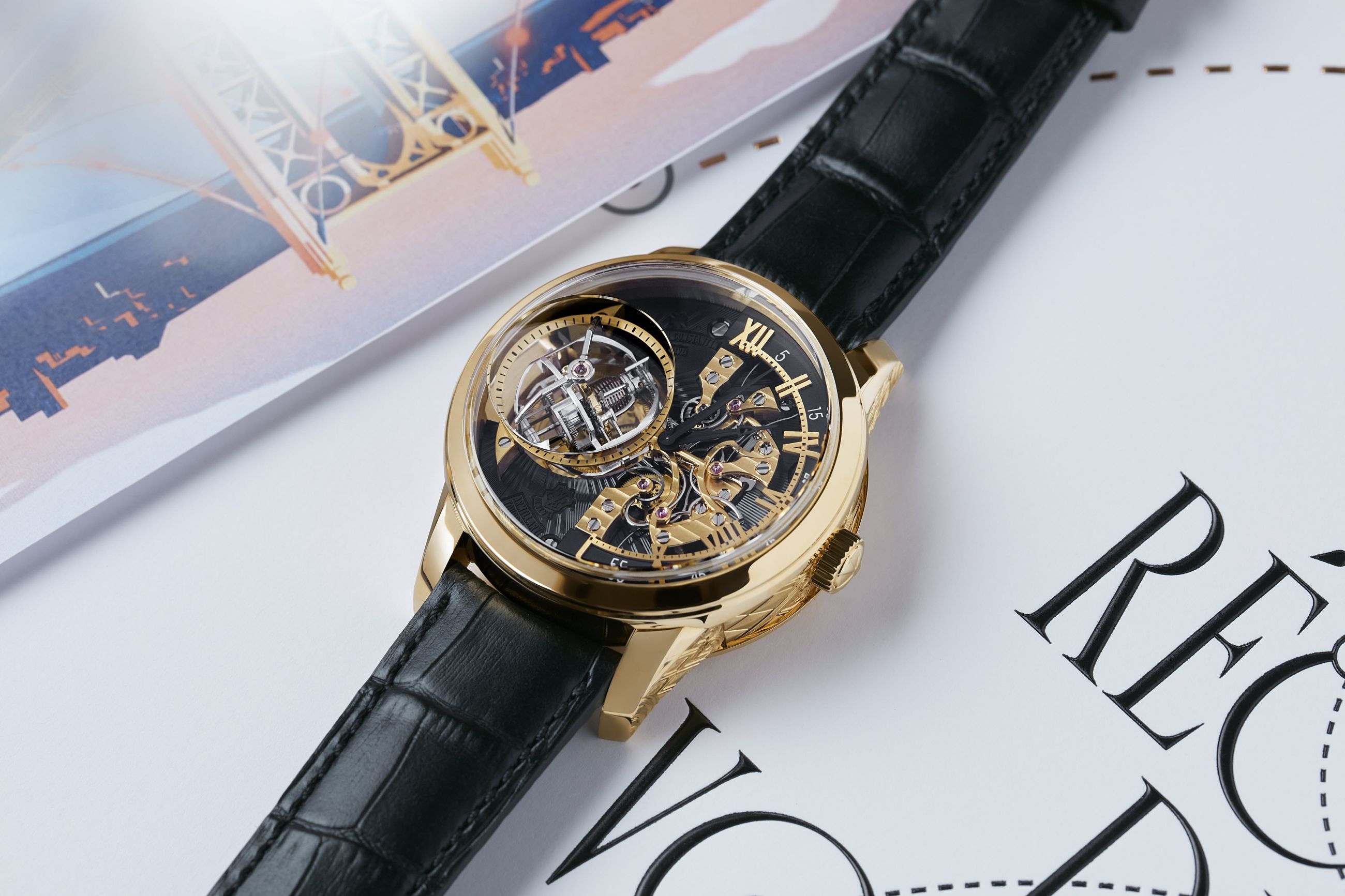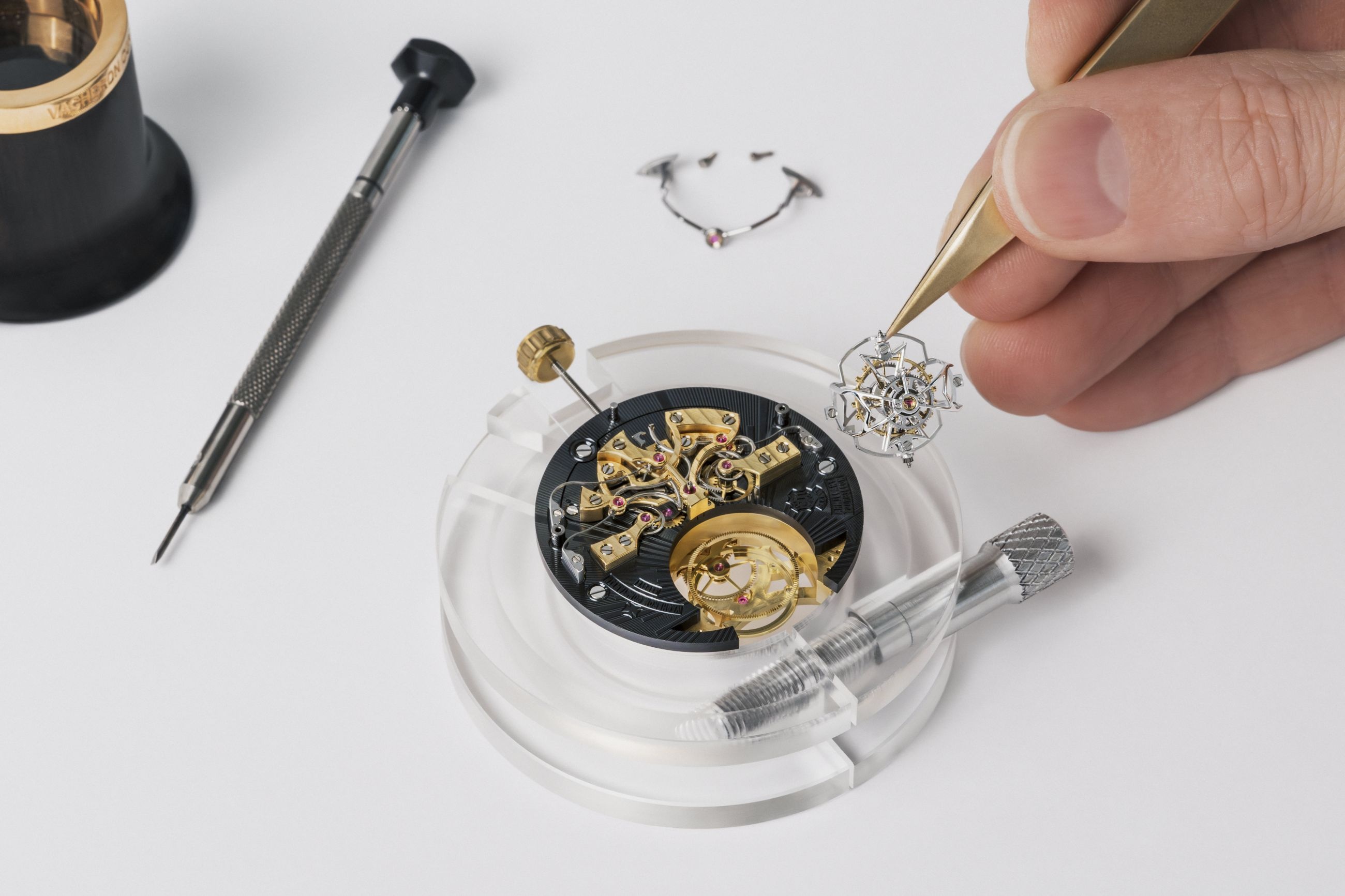Vacheron Constantin Les Cabinotiers Armillary Tourbillon – Tribute to Art Deco Style
- Les Cabinotiers – Récits de Voyages sets off to discover the world and its wonders in the spirit of openness that has characterised Vacheron Constantin since its origins: among the various destinations, the North American leg focuses on the United States, where the Maison has been active since 1832.
- A masterpiece of engraving and guilloché work, this single-piece edition reflects a period of prosperity coupled with extraordinary artistic and cultural dynamism.
- Emblematic of the Maison’s technical mastery, and protected by four patents, in-house Calibre 1990 combines a bi-axial tourbillon with an instantaneous bi-retrograde display.
The single-piece editions in the new Les Cabinotiers – Récits de Voyages collection reflect Vacheron Constantin's geographical expansion, of which the Americas were a major milestone. These new territories became part of the Vacheron Constantin world at a very early stage, with the first contacts made in the United States in 1832, followed by Brazil in 1835 and Mexico ten years later. In the U.S., the turn of the century was marked by an intense period reflecting the principles of Art Deco, which quickly became a comprehensive art form. The new Les Cabinotiers Armillary tourbillon – Tribute to Art Deco style watch, bearing the Hallmark of Geneva, is driven by in-house Calibre 1990 featuring a bi-axial tourbillon regulator with instantaneous bi-retrograde hours and minutes display.
Vacheron Constantin and Americas
Setting up its first representative office in New York as early as 1832, Vacheron Constantin was quick to identify the United States as a key market. The Maison’s watches soon met with success in booming cities such as Philadelphia and New Orleans. Within the space of just a few decades, it found its place among the country's social and cultural personalities, with a clientele including leading lights and captains of industry.
Among the timepieces of historical importance to Vacheron Constantin, many were made for American clients. Aviation pioneers Orville and Wilbur Wright placed an order in 1890 for a pilot’s watch to be strapped to the thigh, the very first of its kind. Three decades later, at a time when the Maison became a shareholder in the American Watch Case Co case manufacturer, the U.S. Army Corps of Engineers ordered several thousand watches. The cushion-shaped American 1921 watch, specifically created for the United States, in turn testifies to the buoyant mood of the Roaring Twenties, which brought a breath of fresh air to the nation. Art Deco was the dominant style at the time, perfectly in keeping with this optimistic, modern vision of a world in the grip of tremendous cultural effervescence. This style imposed new architectural solutions that soon reached dizzying heights in New York, before taking over the fields of furniture, interior design, clothing and cars to the point of becoming a comprehensive art form in the United States.
It was also a time when the wristwatch was beginning to establish itself as the new horological standard, accompanied by the fanciful touches typical of the spirit of the age. This period notably featured the aesthetic of the American 1921, designed by Vacheron Constantin during these years of intense creativity and now celebrated with the new Les Cabinotiers Armillary tourbillon –Tribute to Art Deco style.
A subtle combination of engraving and guilloché
With its highly architectural design, generous armillary tourbillon and openworked dial featuring a bi-retrograde display, the watch offers an ideal creative space for combining aesthetics with Art Deco style codes. Entrusted to the Maison’s master engravers, this task not only involves reworking the bridges and plate of Calibre 1990, but also adorning the case middle with a frieze extending over the lugs.
The master engraver juggled several techniques between the case and the rear movement bridges. Bas-relief serves to obtain a more accentuated motif than drypoint work; the surfaces are hand-chased point by point; while rounding off consists of gently rocking the intaglio tool, whose rounded bevel is fitted with thin sharp steel tips.
The guilloché work complements the engraving techniques applied to the case in 18K 3N yellow gold and to the movement machined from a nickel-silver alloy chosen for its rigidity. On the front, the calibre is entirely hand-guilloché in a perfectly geometrical, purely Art Deco-inspired radiating pattern. The metal has been given a black DLC surface treatment to accentuate the contrast with the colour of the case and bridges, again recalling the combination of brass and wrought iron typical of Art Deco ornamentation.
On the back, the three engraved bridges feature a motif reminiscent of the decorations on New York skyscrapers at the turn of the 20th century, with the added challenge of creating an uninterrupted pattern despite the break between the bridges. It took one month to complete these three components, not counting the bas-relief engraving on the case middle done by the master artisan and extending to the motif created on the back of the movement through a striking play of light and shade accentuated by the depth of the relief. The technique used consists of removing material to bring out the contours of the engraving. After drawing the motifs with a scriber, the master artisan uses the pounced ornament technique, which involves intricate chasing using a scorper, a kind of wider-tipped burin. As the sculpture becomes progressively slimmer, the tool itself becomes thinner. Particularly suited to three-dimensional creations where volumes have little depth, this technique provides scope for breathtakingly accurate details, further enhanced by the finishing. This is the first time that the bridges of Calibre 1990 have been engraved.
Finally, the folding clasp securing the black alligator leather strap of this 45 mm-diameter model was also engraved with Art Deco motifs.
Calibre 1990, a movement featuring historical references
Protected by four patents, Calibre 1990 has benefited from the technical developments made on the Les Cabinotiers Reference 57260 watch, the world's most complex timepiece to date with its 57 complications.
A manual-winding movement with a 58-hour power reserve, Calibre 1990 features an instantaneous bi-retrograde display of the time indications and a bi-axial armillary tourbillon with spherical balance-spring. The time can be read on the right-hand side thanks to a retrograde display with grade 5 titanium hands moving over a semi-circular track punctuated by Roman numerals for the hours and Arabic numerals for the minutes. Confined to a wide flange, this track reveals part of the movement, reinforcing the technical appearance of the timepiece already accentuated by the construction of the regulator.
The configuration of Calibre 1990 frees up the left-hand part of the dial, which is exclusively occupied by the bi-axial armillary tourbillon positioned at 9 o'clock beneath a bubble formed by the sapphire crystal. The distinctive feature of this regulator – oscillating at a rate of 18,000 vibrations per hour and bearing the small seconds hand – is its dual-axis construction with two interlocking aluminium carriages, each rotating at a speed of 60 seconds. At the heart of the tourbillon is a cylindrical balance-spring with no terminal curve, whose perfectly concentric beating ensures greater isochronism and therefore enhanced precision, in addition to the beneficial effect of the regulator's rotation, which neutralises the effects of Earth's gravity.
Each of these two technical developments has its own historical reference. The tourbillon owes its name ‘armillary’ to Antide Janvier, astronomer and watchmaker by appointment to King Louis XVI, one of whose greatest masterpieces was a moving sphere with a planetary wheel known as an armillary. The cylindrical balance-spring dates back to Jacques-Frédéric Houriet's invention in 1814 and is coupled here with an escapement featuring an escape-wheel in silicon with diamond-polished pallets, materials boasting a very low friction coefficient and requiring no lubrication.
Four patents mark the technical innovations of Calibre 1990. These relate firstly to the instantaneous retrograde system, controlled by a single minutes cam that perfectly synchronises the jump of the two hands at midnight or noon. The patented escapement collet – a component securing the inner end of the balance-spring – is made of titanium. This material matches that of the regulating organ, resulting in improved regulatory performance. The third patent concerns the architecture of the tourbillon carriage, which rotates every 15 seconds to form the Vacheron Constantin Maltese cross emblem. The final patent covers the silicon escape-wheel, with its diamond-polished pallets offering greater resistance to wear and friction.
Technical specifications
Vacheron Constantin Les Cabinotiers Armillary Tourbillon – Tribute to Art Deco Style
Reference: 9860C/000J-090C
Unique, one-off timepiece
Case
- Material: 18K 3N hand-engraved yellow gold
- Diameter: 45 mm
- Thickness: 20.10 mm
- Transparent sapphire crystal caseback
Dial and hands
- Black
Movement
- Caliber 1990
- Developed and manufactured by Vacheron Constantin Mechanical manual-winding
- Diameter: 35.50 mm
- Thickness: 10 mm
- Movement power reserve: approximately 58 hours
- Frequency: 2.5 Hz (18’000 vibrations/hour)
- Number of parts: 299
- Number of jewels: 45
- Front bridges: Black hand-guilloché radiant pattern
- Back bridges: hand-engraved geometric pattern
Functions/Indications
- Retrograde hours and minute
- Small seconds on tourbillon
- Armillary tourbillon
Strap and buckle
- Black Mississippiensis alligator leather with alligator leather inner shell, hand-stitched, saddle-finish, large square scales
- 18K 3N hand-engraved yellow gold folding clasp
MSRP: Price on request
For more information, please visit vacheron-constantin.com











Comments
Leave a comment